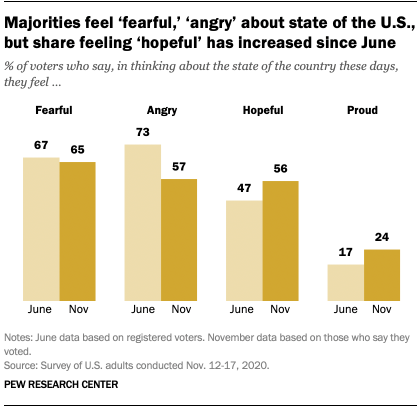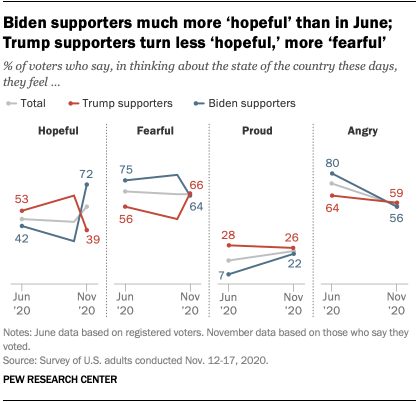As the United States struggles with a surge in COVID-19 cases and ongoing disputes about the Nov. 3 election, majorities of voters continue to say they feel “fearful” and “angry” about the state of the country.
However, the share who say they feel angry has declined since June, while more voters now say they feel “hopeful” than did so then, according to a new national survey by Pew Research Center.
Today, 65% of voters say they are fearful about the state of the country, little changed since June. A smaller majority (57%) say they feel angry, down from 73% five months ago.
At the same time, a 56% majority of voters now say they feel hopeful about the state of the U.S., up from 47% in June. And while only about a quarter of voters (24%) say they feel “proud” about the country, that is 8 percentage points higher than five months ago.
To understand voters’ views about the state of the country after the presidential election, we surveyed 11,818 U.S. adults, including 10,399 U.S. citizens who reported having voted in the presidential election, between Nov. 12-17, 2020. Everyone who took part is a member of Pew Research Center’s American Trends Panel (ATP), an online survey panel that is recruited through national, random sampling of residential addresses. This way nearly all U.S. adults have a chance of selection. The survey is weighted to be representative of the U.S. adult population by gender, race, ethnicity, partisan affiliation, education and other categories. Read more about the ATP’s methodology.
Here are the questions used for this report, along with responses, and its methodology.
Voters who cast their ballots for President-elect Joe Biden are much more hopeful than Biden supporters were in June: 72% now say they are hopeful about the country, compared with 42% then. There also has been a sharp decline in the share of Biden supporters who feel angry, from 80% then to 56% now.
Meanwhile, the share of Biden supporters who feel proud about the state of the country has tripled from a very low level in June, rising from 7% to 22%.
Trump supporters, by contrast, are now far less likely to say they are hopeful about the country than they were five months ago and more likely to be fearful. Only about four-in-ten Trump supporters (39%) feel hopeful, down from 53% in June. The share of Trump supporters who say they are fearful about the state of the country is 11 points higher than it was in June (56% then, 66% now).
As a result of these shifts in opinions since June, roughly similar shares of Trump and Biden supporters now say they are fearful, angry and proud about the country.
Among Biden voters, majorities in all age groups say they are hopeful about the state of the country. But those who are 65 and older are more likely than those in other age groups to say this, while those ages 18 to 34 are least likely to say this (83% of those 65 and older say this, compared with 72% of those 35 to 64 and 60% of those under 35). Similarly, while 29% of Biden voters who are 65 and older feel proud, that compares with 16% among Biden supporters under 35. Those under 35, in turn, are more likely than those 65 and older to say they are angry (63% vs. 49%).
Among Trump voters, those under 35 are somewhat more likely than others to say they are hopeful about the state of the country (46% of 18- to 34-year-old Trump voters, vs. 38% of Trump voters 35 and older).
The public’s overall satisfaction with the state of the country has changed little since before the presidential election. Today, about one-in-five U.S. adults (22%) say they are satisfied with the way things are going in the country; last month, 18% said they were satisfied with national conditions. However, satisfaction is substantially higher than it was in June (12%).
In October, before the election, Republicans and Republican-leaning independents were more likely than Democrats and Democratic leaners to say there were satisfied with the way things were going in the country (30% vs. 7%). Today, similar shares of Republicans (23%) and Democrats (22%) say this.
Note: Here are the questions used for this report, along with responses, and its methodology.

